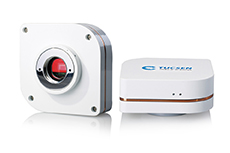
Monochrome, Color and IR extended Sensor models:
| B/W model | Color model | IR extended model (2) | Sensor | Resolution | Pixel µm | ADC bits | Frames per sec (1) | DR dB | Optical size | Power Watt |
|---|---|---|---|---|---|---|---|---|---|---|
| MQ003MG-CM | MQ003CG-CM | - | CMOSIS CMV300 | 648 x 488 | 7.4 | 12 | 500 fps | 60 | 1/3" | 1.6 |
| MQ013MG-E2 | MQ013CG-E2 | MQ013RG-E2 | e2V EV76C560 | 1280 x 1024 | 5.3 | 10 | 60 fps | 60 | 1/1.8" | 0.9 |
| MQ013MG-ON | MQ013CG-ON | MQ013RG-ON | PYTHON 1300 | 1280 x 1024 | 4.8 | 10 | 56 | 1/2" | 1.4 | |
| MQ022MG-CM | MQ022CG-CM | MQ022RG-CM | CMOSIS CMV2000 | 2048 x 1088 | 5.5 | 10 | 170 fps* | 60 | 2/3" | 1.6 |
| MQ042MG-CM | MQ042CG-CM | MQ042RG-CM | CMOSIS CMV4000 | 2048 x 2048 | 5.5 | 10 | 90 fps* | 60 | 1" | 1.6 |
(1) Maximum frame rates measured at 8 bits per pixel raw data in free run mode. Python 1300 model - with Zero ROT feature enabled.
(2) NIR model are based on EV76C661 sensor from e2V, also called Ruby and Near Infrared sensors from CMOSIS
* Please check faster versions available from xiX line based on PCIe interface - special conditions may apply
All models are also available in Board level version with flat ribbon flex cable or Angled connector - ideal for Embedded vision systems.
Common features:
Sensor technology | CMOS, Global shutter |
|---|---|
Acquisition modes | Continuous, software trigger, hardware trigger |
Partial image readout | Multiple ROI / AOI (region/area of interest), Skipping and Binning modes supported (check manual for details) |
Image data formats | 8, 10 or 12 bit RAW pixel data |
SDK/API | programmable with C++ and C# |
Color image processing* | Host based de-Bayering, sharpening, Gamma, color matrix, true color CMS, lookup table (LUT), hue, saturation, sharpness, white balance and more |
Hot/blemish pixels correction* | On camera storage of up to 5000 pixel coordinates, host assisted correction |
Auto adjustments* | Auto white balance, auto gain, auto exposure, HDR (High Dynamic range) |
Flat field corrections* | Host assisted pixel level shading and lens corrections. This feature is being developed and tested |
Interface | USB 3.0 standard Micro B with screw lock threads compliant to USB3 Vision standard |
General purpose I/O | 1x opto-isolated input, 1x opto-isolated output, power LED, 2x LED software programmable |
Signal conditioning* | Programmable debouncing time |
Synchronization | Hardware and software trigger input, exposure strobe output, busy output, bulb, low smear, overlapped |
Housing and lens mount | Standard C mount. Available options are CS mount, S-mount (M12) adapter and board level |
Power requirements | 1 to 1.8W, supplied via USB 3.0 interface |
Dimensions | 26.4 x 26.4 x 26.5 mm (C-mount version) |
Weight | 27 grams (C-mount version) |
Environment | Operating 0°C to 50°C on housing, RH 80% non-condensing, -30°C to 60°C storage |
Conformity | CE, FCC, RoHS, GenICam/GenTL, USB 3.0 SuperSpeed, USB3 Vision Compliant |
Operating systems | Windows 7 SP1 (x86 and x64), W8, 8.1, 10, Linux Ubuntu, ARM, Mac OS X |
Minimum host hardware | Intel i3 3.0GHz, +2GB RAM available physical memory, NVIDIA or Radeon 128MB, Motherboard with PCIe x1 Gen 2 slot, compatible USB 3.0 host adapter |
Software support | API / SDK, adapters and drivers for various image processing Libraries |
Firmware updates | Field firmware update through xiCOP |
(*) Feature is available only when the camera is in XIMEA API mode.






